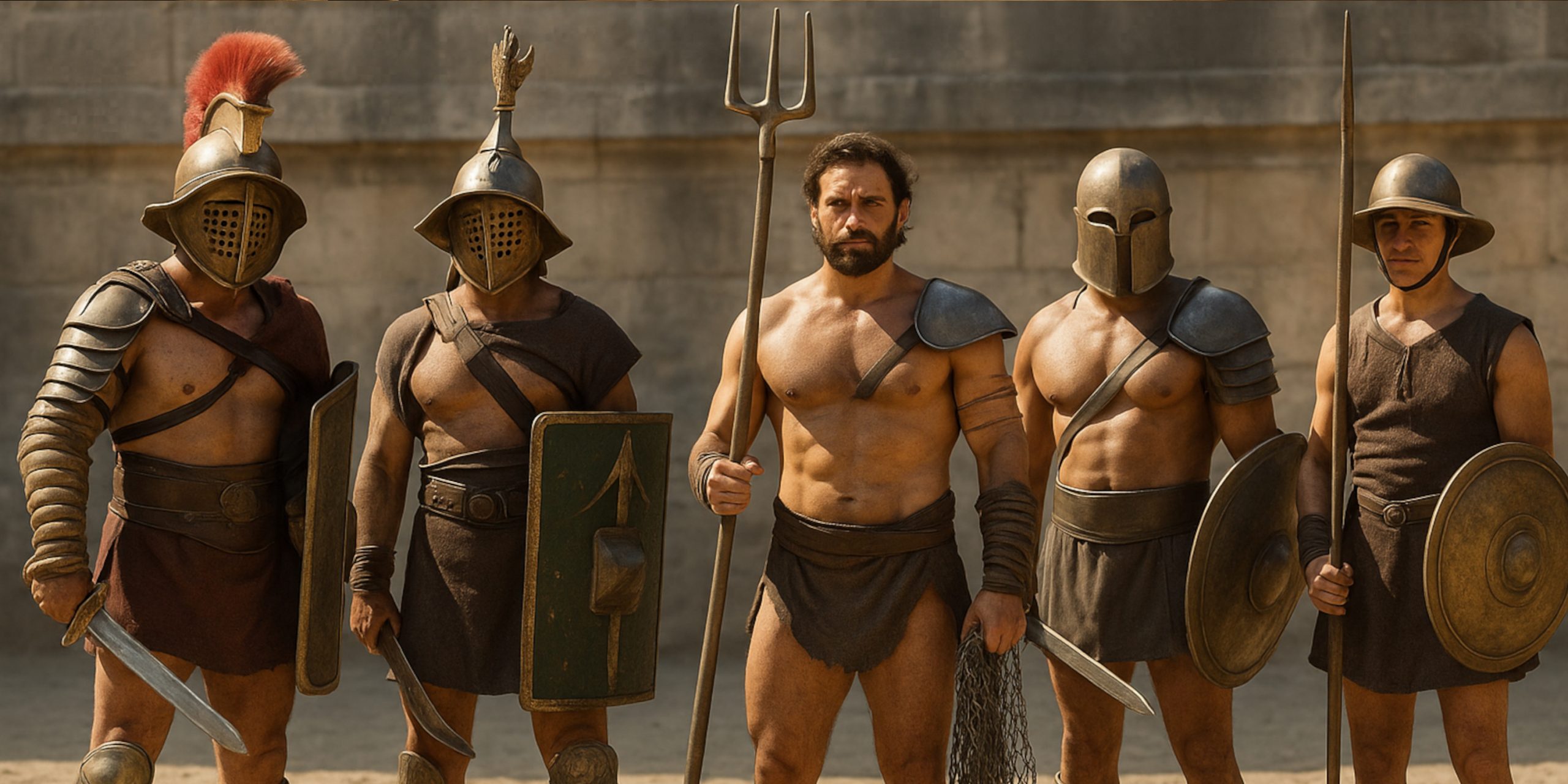
Gladiatorial combat in ancient Rome was not a chaotic free-for-all, but a structured and codified system of martial pairings, each with distinct weapons, armour, and tactical roles. These matches were designed for dramatic tension and spectacle, with complementary strengths and weaknesses between opponents. The fighters, drawn from slaves, prisoners, and volunteers, were trained in specialised schools and often developed personal followings. Below is a breakdown of the key gladiator types and their equipment, alongside the principles behind their matchups.
Murmillo
The murmillo was heavily armed and often paired against more lightly equipped opponents. He typically wore a large, crested helmet with a face guard, a manica (armguard), greave on one leg, and carried a tall rectangular shield (scutum). His primary weapon was the gladius, a short stabbing sword ideal for thrusting in close quarters.
Combat Style: He relied on defence, shield pressure, and powerful forward drives. His size and protection made him formidable, though slower.
Common Opponents: Thraex or hoplomachus, both more mobile and reliant on agility.
Thraex (Thracian)
Named after Thracian warriors, this type fought with a curved short sword called a sica, designed to bypass shields. He carried a small square or round shield (parmula) and wore high greaves on both legs. His helmet had a tall crest and wide brim, limiting vision but adding protection.
Combat Style: Fast and elusive, the Thraex aimed for slashing strikes, using agility and angles to get around the heavier murmillo’s guard.
Retiarius
The most unorthodox and visually striking type, the retiarius carried no helmet or shield. His weapons were a trident (fuscina), a weighted throwing net (rete), and a dagger (pugio). He wore a manica and a galerus (shoulder guard) on his left arm for protection.
Combat Style: Speed and reach were key. The net was used to entangle or distract, followed by thrusts with the trident. This style relied on distance and timing.
Common Opponent: Secutor, a heavier, more protected gladiator designed to counter him.
Secutor
Developed specifically to face the retiarius, the secutor wore a smooth, rounded helmet with small eye holes to prevent the net from catching. He carried a scutum and gladius, with similar armour to the murmillo but with less decoration.
Combat Style: Relentless pursuit. The secutor aimed to close the gap quickly and render the retiarius’ range advantage ineffective.
Hoplomachus
Inspired by Greek hoplites, this type wore a brimmed helmet, high greaves, and carried a spear and a short sword or dagger. His shield was round, not unlike the Greek aspis.
Combat Style: Balanced between reach and close fighting. The spear gave initial range, then he transitioned to his sidearm when needed.
Common Opponent: Murmillo, creating a clash between spear and sword, circle and rectangle.
Dimachaerus
A more exotic and rarer type, the dimachaerus wielded two swords (usually sica or gladius types) and wore little to no armour.
Combat Style: Fast and dual-handed, relying on flanking strikes, constant movement, and deception. Vulnerable due to lack of protection.
Provocator
Generally considered an earlier type, the provocator was relatively well-armoured, with a gladius and scutum, plus a full helmet and chest plate (pectorale).
Combat Style: Straightforward and disciplined. Often pitted against another provocator in standardised matches without significant asymmetry.
Equites
Mounted gladiators who began combat on horseback with a lance and transitioned to foot combat using a gladius and round shield. They were typically matched only against each other.
Combat Style: Cavalry charges followed by dismounted swordplay. Their matches were more ritualised and less lethal.
Andabatae
An obscure and arguably theatrical class, possibly used for comic relief. They wore helmets with no eye holes and fought blindly, either on foot or horseback.
Combat Style: Clumsy and chaotic, these matches were more about entertainment than skill.
Gladiator Schools and Training
Gladiators were trained in ludi, state-sanctioned schools led by a lanista. Training focused not only on physical conditioning and weapon use but also on performing to an audience. Matches followed choreographed conventions, and while fights could be brutal, many did not end in death. Successful gladiators gained fame, wealth, and in rare cases, freedom.
Arms and Armour: Summary Table
| Gladiator Type | Primary Weapon(s) | Shield | Armour | Notable Features |
|---|---|---|---|---|
| Murmillo | Gladius | Scutum | Helmet, manica, greave | Heavy and defensive |
| Thraex | Sica | Parmula | Helmet, greaves | Agile and aggressive |
| Retiarius | Trident, net, dagger | None | Manica, galerus | Light, ranged |
| Secutor | Gladius | Scutum | Smooth helmet, manica | Built to chase Retiarius |
| Hoplomachus | Spear, dagger | Round | Helmet, greaves | Hybrid fighter |
| Dimachaerus | Two swords | None | Minimal | Fast and deadly |
| Provocator | Gladius | Scutum | Helmet, pectorale | Classic form |
| Equites | Lance, gladius | Round | Tunic, helmet | Fought on horseback |
| Andabatae | Unknown | Unknown | Helmet with no vision | Spectacle-based |
Legacy
Gladiator combat was a central part of Roman mass entertainment, blending violence with theatricality. The variety in weapons and styles added depth and structure to the fights, enhancing their appeal. Although brutal, the world of the gladiator was one of discipline, skill, and in some cases, adoration. Understanding the different styles reveals a complex and ritualised martial culture, rather than just bloodsport.
Watch the documentary:



